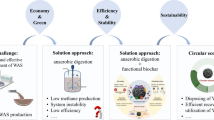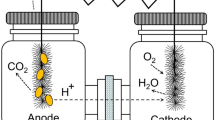Abstract
Anaerobic digestion (AD) of food waste diverts organic waste from landfills, generates sustainable baseload energy, and potentially an ecotoxic ammonia-rich digestate that requires post-treatment. Successful application of algal-based technology to treating high-ammonia AD effluents can be achieved by freshwater dilution. However, dilution of high-strength effluents with freshwater is currently unsustainable. Here, the feasibility of growing Chlorella sp. on the effluent of food waste anaerobic digestate with high ammonia content under recycling of the treated effluent was investigated for nutrient management and biomass production. The performance of the Chlorella sp. cultivated in repeated batch with effluent recycling (BR) and without recycling (BNR) was compared with repeated fed-batch mode with recycling (FR) and without recycling (FNR). Maximum cell density (6.1 × 107 cells mL−1) corresponding to the highest chlorophyll a (23.3 ± 1.3 mg L−1) content was found in the FNR. Ammonia removal rates were not significantly different among all tested treatments. In all treatments, the analysis of the operating efficiency of PSII photochemistry (Fq′/Fm′) of the culture showed values > 0.5, indicating cells were not subjected to physiological stress. Harvested Chlorella biomass composition showed no variation in the contents of total protein, carbohydrate, and lipids. Turbidity increase in cultures with effluent recycling versus without recycling was negligible (5%), demonstrating the suitability of effluent recycling in the microalgae-based treatment of high-strength ammonia food waste digestate.





Similar content being viewed by others
References
An J-Y, Sim S-J, Lee JS, Kim BW (2003) Hydrocarbon production from secondarily treated piggery wastewater by the green alga Botryococcus braunii. J Appl Phycol 15:185–191
Ayre JM, Moheimani NR, Borowitzka MA (2017) Growth of microalgae on undiluted anaerobic digestate of piggery effluent with high ammonium concentrations. Algal Res 24:218–226
Bjornsson WJ, Nicol RW, Dickinson KE, McGinn PJ (2013) Anaerobic digestates are useful nutrient sources for microalgae cultivation: functional coupling of energy and biomass production. J Appl Phycol 25:1523–1528
Bohutskyi P, Liu K, Nasr LK, Byers N, Rosenberg JN, Oyler GA, Betenbaugh MJ, Bouwer EJ (2015) Bioprospecting of microalgae for integrated biomass production and phytoremediation of unsterilized wastewater and anaerobic digestion centrate. Appl Microbiol Biotechnol 99:6139–6154
Borowitzka MA (2018) The ‘stress’ concept in microalgal biology—homeostasis, acclimation and adaptation. J Appl Phycol 30:2815–2825
Cheng J, Ye Q, Xu J, Yang Z, Zhou J, Cen K (2016) Improving pollutants removal by microalgae Chlorella PY-ZU1 with 15% CO2 from undiluted anaerobic digestion effluent of food wastes with ozonation pretreatment. Bioresour Technol 216:273–279
Eaton A, Clesceri L, Rice E, Greenberg A, Franson M (2005) Standard methods for the examination of water and wastewater, 21st edn. American Public Health Association, American Waterworks Association, Water Environmental Federation. Port City Press, Pikeville
Ermis H, Altinbas M (2019) Determination of biokinetic coefficients for nutrient removal from anaerobic liquid digestate by mixed microalgae. J Appl Phycol 31:1773–1781
Garcia J, Mujeriego R, Hernandez-Marine M (2000) High rate algal pond operating strategies for urban wastewater nitrogen removal. J Appl Phycol 12:331–339
He P, Mao B, Shen C, Shao L, Lee D, Chang J (2013) Cultivation of Chlorella vulgaris on wastewater containing high levels of ammonia for biodiesel production. Bioresour Technol 129:177–181
Ishika T, Moheimani NR, Bahri PA (2017) Sustainable saline microalgae co-cultivation for biofuel production: a critical review. Renew Sust Energ Rev 78:356–368
Ji F, Zhou Y, Pang A, Ning L, Rodgers K, Liu Y, Dong R (2015) Fed-batch cultivation of Desmodesmus sp. in anaerobic digestion wastewater for improved nutrient removal and biodiesel production. Bioresour Technol 184:116–122
Koutra E, Grammatikopoulos G, Kornaros M (2017) Microalgal post-treatment of anaerobically digested agro-industrial wastes for nutrient removal and lipids production. Bioresour Technol 224:473–480
Krishna Mohan TV, Nancharaiah YV, Venugopalan VP, Satya Sai PM (2018) Denitrification kinetics of high-strength nitrate in granular sludge reactors. CLEAN–Soil, Air, Water 46:1800239
Li Y, Chen Y-F, Chen P, Min M, Zhou W, Martinez B, Zhu J, Ruan R (2011) Characterization of a microalga Chlorella sp. well adapted to highly concentrated municipal wastewater for nutrient removal and biodiesel production. Bioresour Technol 102:5138–5144
Markou G (2015) Fed-batch cultivation of Arthrospira and Chlorella in ammonia-rich wastewater: optimization of nutrient removal and biomass production. Bioresour Technol 193:35–41
Moheimani NR (2013) Long-term outdoor growth and lipid productivity of Tetraselmis suecica, Dunaliella tertiolecta and Chlorella sp (Chlorophyta) in bag photobioreactors. J Appl Phycol 25:167–176
Moheimani N (2016) Tetraselmis suecica culture for CO2 bioremediation of untreated flue gas from a coal-fired power station. J Appl Phycol 28:2139–2146
Moheimani NR, Borowitzka MA, Isdepsky A, Fon Sing S (2013) Standard methods for measuring growth of algae and their composition. In: Borowitzka MA, Moheimani NR (eds) Algae for biofuels and energy. Springer, Dordrecht, pp 265–284
Molinuevo-Salces B, García-González MC, González-Fernández C (2010) Performance comparison of two photobioreactors configurations (open and closed to the atmosphere) treating anaerobically degraded swine slurry. Bioresour Technol 101:5144–5149
Nwoba EG, Ayre JM, Moheimani NR, Ubi BE, Ogbonna JC (2016) Growth comparison of microalgae in tubular photobioreactor and open pond for treating anaerobic digestion piggery effluent. Algal Res 17:268–276
Nwoba EG, Moheimani NR, Ubi BE, Ogbonna JC, Vadiveloo A, Pluske JR, Huisman JM (2017) Macroalgae culture to treat anaerobic digestion piggery effluent (ADPE). Bioresour Technol 227:15–23
Nwoba EG, Parlevliet DA, Laird DW, Alameh K, Moheimani NR (2019a) Sustainable phycocyanin production from Arthrospira platensis using solar-control thin film coated photobioreactor. Biochem Eng J 141:232–238
Nwoba EG, Parlevliet DA, Laird DW, Vadiveloo A, Alameh K, Moheimani NR (2019b) Can solar control infrared blocking films be used to replace evaporative cooling for growth of Nannochloropsis sp. in plate photobioreactors? Algal Res 39:101441
Parkhill JP, Maillet G, Cullen JJ (2001) Fluorescence-based maximal quantum yield for PSII as a diagnostic of nutrient stress. J Phycol 37:517–529
Plana PV, Noche B (2016) A review of the current digestate distribution models: storage and transport. WIT Trans Ecol Environ 202:345–357
Petropoulos P, Gilbride KA (2005) Nitrification in activated sludge batch reactors is linked to protozoan grazing of the bacterial population. Can J Microbiol 51:791-799
Pouliot Y, Buelna G, Racine C, De la Noüe J (1989) Culture of cyanobacteria for tertiary wastewater treatment and biomass production. Biol Wastes 29:81–91
Raeisossadati M, Vadiveloo A, Bahri PA, Parlevliet D, Moheimani NR (2019) Treating anaerobically digested piggery effluent (ADPE) using microalgae in thin layer reactor and raceway pond. J Appl Phycol 1–9. https://doi.org/10.1007/s10811-019-01760-6
Samorì G, Samorì C, Guerrini F, Pistocchi R (2013) Growth and nitrogen removal capacity of Desmodesmus communis and of a natural microalgae consortium in a batch culture system in view of urban wastewater treatment: part I. Water Res 47:791–801
Shin DY, Cho HU, Utomo JC, Choi Y-N, Xu X, Park JM (2015) Biodiesel production from Scenedesmus bijuga grown in anaerobically digested food wastewater effluent. Bioresour Technol 184:215–221
Singh M, Reynolds DL, Das KC (2011) Microalgal system for treatment of effluent from poultry litter anaerobic digestion. Bioresour Technol 102:10841–10848
Vadiveloo A, Moheimani NR, Cosgrove JJ, Parlevliet D, Bahri PA (2017) Effects of different light spectra on the growth, productivity and photosynthesis of two acclimated strains of Nannochloropsis sp. J Appl Phycol 29:1765–1774
Vadiveloo A, Nwoba EG, Moheimani NR (2019) Viability of combining microalgae and macroalgae cultures for treating anaerobically digested piggery effluent. J Environ Sci 82:132–144
Wang L, Li Y, Chen P, Min M, Chen Y, Zhu J, Ruan RR (2010) Anaerobic digested dairy manure as a nutrient supplement for cultivation of oil-rich green microalgae Chlorella sp. Bioresour Technol 101:2623–2628
Weerasekara AW, Jenkins S, Abbott LK, Waite I, McGrath JW, Larma I, Eroglu E, O’Donnell A, Whiteley AS (2016) Microbial phylogenetic and functional responses within acidified wastewater communities exhibiting enhanced phosphate uptake. Bioresour Technol 220:55–61
Weiland P (2010) Biogas production: current state and perspectives. Appl Bicrobiol Biotechnol 85:849–860
Xie Y, Ho S-H, Chen C-NN, Chen C-Y, Ng I-S, Jing K-J, Chang J-S, Lu Y (2013) Phototrophic cultivation of a thermo-tolerant Desmodesmus sp. for lutein production: effects of nitrate concentration, light intensity and fed-batch operation. Bioresour Technol 144:435–444
Zhu L, Yan C, Li Z (2016) Microalgal cultivation with biogas slurry for biofuel production. Bioresour Technol 220:629–636
Zhu S, Feng S, Xu Z, Qin L, Shang C, Feng P, Wang Z, Yuan Z (2019) Cultivation of Chlorella vulgaris on unsterilized dairy-derived liquid digestate for simultaneous biofuels feedstock production and pollutant removal. Bioresour Technol 285:121353
Acknowledgments
This work was supported by Richgro Garden Products, WA.
Author information
Authors and Affiliations
Corresponding author
Additional information
Publisher’s note
Springer Nature remains neutral with regard to jurisdictional claims in published maps and institutional affiliations.
Rights and permissions
About this article
Cite this article
Nwoba, E.G., Mickan, B.S. & Moheimani, N.R. Chlorella sp. growth under batch and fed-batch conditions with effluent recycling when treating the effluent of food waste anaerobic digestate. J Appl Phycol 31, 3545–3556 (2019). https://doi.org/10.1007/s10811-019-01878-7
Received:
Revised:
Accepted:
Published:
Issue Date:
DOI: https://doi.org/10.1007/s10811-019-01878-7




